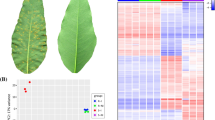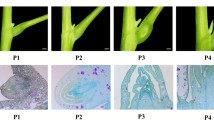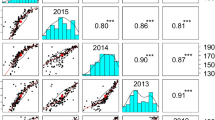Abstract
Bolting or flowering time affects productivity of the leafy vegetable Chinese cabbage (Brassica rapa ssp. pekinensis) and also the time required for its breeding programs. Understanding the bolting process at the molecular level and identifying the genes involved will provide valuable tools for genetic engineering and development of functional markers. To achieve these goals, microarray analyses using either outer leaves or core tissues of completely headed Chinese cabbage were performed at three developmental stages, and the findings were confirmed using RT-PCR. A large number of genes were specifically or preferentially expressed in each tissue: photosynthesis and abiotic signal responding genes were expressed in outer leaves, while genes involved in hormone responses, flower development, and histone modification were expressed in core tissues. Genes promoting bolting, such as BrPIF4, BrPIF5, and BrCOLs, were highly expressed in outer leaves, a signal-perceiving tissue, whereas floral repressors, such as BrFLCs, BrFRL, and BrMAF1s, were predominantly expressed in core tissues, with levels of expression decreasing in later stages. Although the B. rapa genome contains three BrFT paralogs, only BrFT1 was expressed. BrFD and BrFE, genes related to the transport of BrFTs, showed consistent expression. The late bolting phenotype of Huissen, the F1 variety examined in this study, may result from expression of repressors of flowering, such as BrGASA5, BrTFL1, BrMAF1, BrFLCs, and BrKNAT1, in core tissues. Coordinated regulation of several floral promoters and repressors appears to be necessary for control of the bolting process or flowering time in B. rapa.






Similar content being viewed by others
References
Abe M, Kobayashi Y, Yamamoto S, Daimon Y, Yamaguchi A, Ikeda Y, Ichinoki H, Notaguchi M, Goto K, Araki T (2005) FD, a bZIP protein mediating signals from the floral pathway integrator FT at the shoot apex. Science 309:1052–1056
Abe M, Kaya H, Watanabe-Taneda A, Shibuta M, Yamaguchi A, Sakamoto T, Kurata T, Ausín I, Araki T, Alonso-Blanco C (2015) FE, a phloem-specific Myb-related protein, promotes flowering through transcriptional activation of FLOWERING LOCUS T and FLOWERING LOCUS T INTERACTING PROTEIN 1. Plant J 83:1059–1068
Bouche F, Lobet G, Tocquin P, Perilleux C (2015) FLOR-ID: an interactive database of flowering-time gene networks in Arabidopsis thaliana. Nucleic Acids Res 44(D1):D1167–D1171
Celenza JL, Quiel JA, Smolen GA, Merrikh H, Silvestro AR, Normanly J, Bender J (2005) The Arabidopsis ATR1 Myb transcription factor controls indolic glucosinolate homeostasis. Plant Physiol 137:253–262
Chia TY, Müller A, Jung C, Mutasa-Göttgens ES (2008) Sugar beet contains a large CONSTANS-LIKE gene family including a CO homologue that is independent of the early-bolting (B) gene locus. J Exp Bot 59:2735–2748
Corbesier L, Vincent C, Jang S, Fornara F, Fan Q, Searle I, Giakountis A, Farrona S, Gissot L, Turnbull C, Coupland G (2007) FT protein movement contributes to long-distance signaling in floral induction of Arabidopsis. Science 316:1030–1033
Dechaine JM, Brock MT, Weinig C (2014) QTL architecture of reproductive fitness characters in Brassica rapa. BMC Plant Biol 14:66
Ding Z, Li S, An X, Liu X, Qin H, Wang D (2009) Transgenic expression of MYB15 confers enhanced sensitivity to abscisic acid and improved drought tolerance in Arabidopsis thaliana. J Genet Genomics 36:17–29
Ding ZJ, Yan JY, Li CX, Li GX, Wu YR, Zheng SJ (2015) Transcription factor WRKY46 modulates the development of Arabidopsis lateral roots in osmotic/salt stress conditions via regulation of ABA signaling and auxin hometostasis. Plant J 84:56–69
Ditta G, Pinyopich A, Robles P, Pelaz S, Yanofsky MF (2004) The SEP4 gene of Arabidopsis thaliana functions in floral organ and meristem identity. Curr Biol 14:1935–1940
Dong X, Feng H, Xu M, Lee J, Kim YK, Lim YP, Piao Z, Park YD, Ma H, Hur Y (2013) Comprehensive analysis of genic male sterility-related genes in Brassica rapa using a newly developed Br 300 K oligomeric chip. PLoS ONE 8(9):e72178
Du Z, Zhou X, Ling Y, Zhang Z, Su Z (2010) agriGO: a GO analysis toolkit for the agricultural community. Nucleic Acids Res 38:W64–W70
Duan W, Song X, Liu T, Huang Z, Ren J, Hou X, Li Y (2015) Genome-wide analysis of the MADS-box gene family in Brassica rapa (Chinese cabbage). Mol Genet Genomics 290:239–255
Franks SJ, Perez-Sweeney B, Strahl M, Nowogrodzki A, Weber JJ, Lalchan R, Jordan KP, Litt A (2015) Variation in the flowering time orthologs BrFLC and BrSOC1 in a natural population of Brassica rapa. Peer J 3:e1339
Gadqe PP, Wagh SK, Shaikh FK, Tak RD, Padul MV, Kachole MS (2015) A bifunctional & #x03B1;-amlylase/trypsin inhibitor from pigeonpea seeds: purification, biochemical characterization and its bio-efficacy against Hlicoverpa armigera. Pestic Biochem Physiol 125:17–25
Galvão VC, Collani S, Horrer D, Schmid M (2015) Gibberellic acid signaling is required for ambient temperature-mediated induction of flowering in Arabidopsis thaliana. Plant J 84:949–962
Gangappa SN, Botto JF (2014) The BBX family of plant transcription factors. Trends Plant Sci 19:460–470
Giakountis A, Coupland G (2008) Phloem transport of flowering signals. Curr Opin Plant Biol 11:687–694
Gómez-Campo C, Prakash S (1999) Origin and domestication. In: Gómez-Campo By (ed) Biology of Brassica Coenospecies. Elsevier, Amsterdam, pp 33–58
Hanano S, Goto K (2011) Arabidopsis TERMINAL FLOWER1 is involved in the regulation of flowering time and inflorescence development through transcriptional repression. Plant Cell 23:3172–3184
He Y, Amasino RM (2005) Role of chromatin modification in flowering-time control. Trends Plant Sci 10:30–35
Hébrard C, Peterson DG, Willems G, Delaunay A, Jesson B, Lefèbvre M, Barnes S, Maury S (2015) Epigenomics and bolting tolerance in sugar beet genotypes. J Exp Bot 67:207–225
Jin J, Zhang H, Kong L, Gao G, Luo J (2014) PlantTFDB 3.0: a portal for the functional and evolutionary study of plant transcription factors. Nucleic Acids Res 42 (Database issue):D1182-1187
Kakizaki T, Kato T, Fukino N, Ishida M, Hatakeyama K, Matsumoto S (2011) Identification of quantitative trait loci controlling late bolting in Chinese cabbage (Brassica rapa L.) parental like Nou 6 gou. Breeding Sci 61:151–159
Kim JH, Choi D, Kende H (2003) The AtGRF family of putative transcription factors is involved in leaf and cotyledon growth in Arabidopsis. Plant J 36:94–104
Kobayashi K, Sasaki D, Noguchi K, Fujinuma D, Komatsu H, Kobayashi M, Sato M, Toyooka K, Sugimoto K, Niyogi KK, Wada H, Masuda T (2013) Photosynthesis of root chloroplasts developed in Arabidopsis lines overexpressing GOLDEN2-LIKE transcription factors. Plant Cell Physiol 54:1365–1377
Lee H, Suh SS, Park E, Cho E, Ahn JH, Kim SG, Lee JS, Kwon YM, Lee I (2000) The AGAMOUS-LIKE 20 MADS domain protein integrates floral inductive pathway in Arabidopsis. Genes Dev 14:2366–2376
Li F, Kitashiba H, Inaba K, Nishio T (2009) A Brassica rapa linkage map of EST-based SNP markers for identification of candidate genes controlling flowering time and leaf morphological traits. DNA Res 16:311–323
Li X, Ramchiary N, Dhandapani V, Choi SR, Hur Y, Nou IS, Yoon MK, Lim YP (2013) Quantitative trait loci mapping in Brassica rapa revealed the structural and functional conservation of genetic loci governing morphological and yield component traits in the A, B, and C subgenomes of Brassica species. DNA Res 20:1–16
Li X, Wang W, Wang Z, Li K, Lim YP, Piao Z (2015) Construction of chromosome segment substitution lines enables QTL mapping for flowering and morphological traits in Brassica rapa. Front. Plant Sci 6:432
Lim MH, Kim J, Kim YS, Chung KS, Seo YH, Lee I, Kim J, Hong CB, Kim HJ, Park CM (2004) A new Arabidopsis gene, FLK, encodes an RNA binding protein with K homology motifs and regulates flowering time via FLOWERING LOCUS C. Plant Cell 16:731–740
Lin M, Belanger H, Lee Y, Varkonyi-Gasic E, Taoka K, Miura E et al (2007) FLOWERNG LOCUS T protein may act as the long-distance florigenic signal in the Cucurbits. Plant Cell 19:1488–1506
Liu L, Zhu Y, Shen L, Yu H (2013) Emerging insights into florigen transport. Curr Opin Plant Biol 16:607–613
Lou P, Zhao J, Kim JS, Shen S, Carpio DPD, Song X, Jin M, Vreugdenhil D, Wang X, Koornneef M, Bonnema G (2007) Quantitative trait loci for flowering time and morphological traits in multiple populations of Brassica rapa. J Exp Bot 58:4005–4016
Lu KJ, Huang NC, Liu YS, Lu CA, Yu TS (2012) Long-distance movement of Arabidopsis FLOWERING LOCUS T RNA participates in systemic floral regulation. RNA Biol 9:653–662
Martínze-Bello L, Moritz T, López-Díaz I (2015) Silencing C19-GA 2-oxidases induces parthenocarpic development and inhibits lateral branching in tomato plants. J Exp Bot 66:5897–5910
Masaki T, Tsukagoshi H, Mitsui N, Tm Nishii, Hattori T, Morikami A (2005) Activation tagging to a gene for a protein with novel class of CCT-domain activates expression of a subset of sugar-inducible genes in Arabidopsis thaliana. Plant J 43:142–152
Messenguy F, Dubois E (2003) Role of MADS box proteins and their cofactors in combinatorial control of gene expression and cell development. Gene 316:1–21
Michaels SD, Amasino RM (1999) FLOWERING LOCUS C encodes a novel MADS domain protein that acts as a repressor of flowering. Plant Cell 11:949–956
Mizukami Y, Ma H (1992) Ectopic expression of the floral homeotic gene AGAMOUS in transgenic Arabidopsis plants alters floral organ identity. Cell 71:119–131
Nie S, Xu L, Wang Y, Huang D, Muleke EM, Sun X, Wang R, Xie Y, Gong Y, Liu L (2015) Identification of bolting-related microRNAs and their targets reveals complex miRNA-mediated flowering-time regulatory networks in radish (Raphanus sativus L.). Sci Rep 5:14034
Nole-Wilson S, Krizek BA (2000) DNA binding properties of the Arabidopsis floral development protein AINTEGUMENTA. Nucleic Acids Res 28(21):4076–4082
Putterill J, Robson F, Lee K, Simon R, Coupland G (1995) The CONSTANS gene of Arabidopsis promotes flowering and encodes a protein showing similarities to zinc finger transcription factors. Cell 80:847–857
Roxrud I, Lid SE, Fletcher JC, Schmidt EDL, Opsahl-sorteberg HG (2007) GASA4, one of the 14 member Arabidopsis GASA family of samll polypeptides, regulates flowering and seed development. Plant Cell Physiol 48:471–483
Saha G, Park JI, Jung HJ, Ahmed NU, Kayum MA, Chung MY, Hur Y, Cho YG, Watanabe M, Nou IS (2015) Genome-wide identification and characterization of MADS-box family genes related to organ development and stress resistance in Brassica rapa. BMC Genom 16:178
Samach A, Onouchi H, Gold SE, Ditta GS, Schwarz-Sommer Z, Yanofsky MF, Coupland G (2000) Distinct roles of CONSTANS target genes in reproductive development of Arabidopsis. Scinece 288:1613–1616
Scortecci KC, Michaels SD, Amasino RM (2001) Identification of a MADS-box gene, FLOWERING LOCUS M, that represses flowering. Plant J 26:229–236
Shani E, Burko Y, Ben-Yaakov L, Berger Y, Amsellem Z, Goldshmidt A, Sharon E, Ori N (2009) Stage-specific regulation of Solanum lycopersicum leaf maturation by class 1 KNOTTED1-LIKE HOMEOBOX protein. Plant Cell 21:3078–3092
Sheldon CC, Rouse DT, Finnegan EJ, Peacock WJ, Dennis ES (2000) The molecular basis of vernalization: the central role of Flowering locus C (FLC). Proc Natl Acad Sci USA 97:3753–3758
Siefers N, Dang KK, Kumimoto RW, Bynum WEt, Tayrose G, Holt BF (2009) Tissue-specific expression patterns of Arabidopsis NF-Y transcription factors suggest potential for extensive combinatorial complexity. Plant Physiol 149(2):625–641
Smaczniak C, Immink RG, Angenent GC, Kaufmann K (2012) Developmental and evolutionary diversity of plant MADS-domain factors: insights from recent studies. Development 139:3081–3098
Song YH, Shim JS, Kinmonth-Schultz HA, Imaizumi T (2015a) Photoperiodic flowering: time measurement mechanisms in leaves. Annu Rev Plant Biol 66:441–464
Song X, Duan W, Huang Z, Liu G, Wu P, Liu T, Li Y, Hou X (2015b) Comprehensive analysis of the flowering genes in Chinese cabbage and examination of evolutionary pattern of CO-like genes in plant kingdom. Sci Rep 5:14631
Srikanth A, Schmid M (2011) Regulation of flowering time: all roads lead to Rome. Cell Mol Life Sci 68:2013–2037
Takada S, Goto K (2003) Terminal flower 2, an Arabidopsis homolog of heterochromatin protein 1, counteracts the activation of flowering locus T by constans in the vascular tissues of leaves to regulate flowering time. Plant Cell 15:2856–2865
Takahashi K, Shimada T, Knondo M, Tamai A, Mori M, Nishimura M, Hara-Nishimura I (2010) Ectopic expression of an esterase, which is a candidate for the unidentified plant cutinase, causes cuticular defects in Arabidopsis thaliana. Plant Cell Physiol 51:123–131
Tsuji H, Taoka K (2014) Florigen signaling. Enzymes 35:113–144
U N (1935) Genomic analysis in Brassica with specific reference to the experimental formation of B. napus and peculiar mode of fertilization. Jpn J Bot 7:389–452
Wang YG, Zhang L, Ji XH, Yan JF, Liu YT, Lv XX, Feng H (2014) Mapping of quantitative trait loci for the bolting traits in Brassic rapa under vernalizing conditions. Genet Mol Res 13:3927–3939
Willmann MR, Poethig RS (2011) The effect of the floral repressor FLC on the timing and progression of vegetative phase change in Arabidopsis. Development 138:677–685
Xiao D, Zhao JJ, Hou XL, Basnet RK, CarpioDPD Zhang NW, Bucher J, Lin K, Cheng F, Wang XW, Bonnema G (2013) The Brassica rapa FLC homologue FLC2 is a key regulatory of flowering time, identified through transcriptional co-expression networks. J Exp Bot 64:4503–4516
Yamasaki K, Kigawa T, Inoue M, Tateno M, Yamasaki T, Yabuki T, Aoki M, Seki E, Matsuda T, Nunokawa E, Ishizuka Y, Terada T, Shirouzu M, Osanai T, Tanaka A, Seki M, Shinozaki K, Yokoyama S (2004) A novel zinc-binding motif revealed by solution structures of DNA-binding domains of Arabidopsis SBP-family transcription factors. J Mol Biol 337(1):49–63
Zeevaart JA (2008) Leaf-produced floral signals. Curr Opin Plant Biol 11:541–547
Zhang Z, Ober JA, Kliebenstein DJ (2006) The gene controlling the quantitative trait locus EPITHIOSPECIFIER MODIFIER1 alters glucosinolate hydrolysis and insect resistance in Arabidopsis. Plant Cell 18:1524–1536
Zhang S, Yang C, Peng J, Sun S, Wang X (2009) GASA5, a regulator of flowering time and stem growth in Arabidopsis thaliana. Plant Mol Biol 69:745–759
Acknowledgments
This research was supported by research Grants from Golden Seed Project (Center for Horticultural Seed Development, Nos. 213003-04-4-CG100 and 213003-04-4-SB230), Ministry of Agriculture, Food and Rural Affairs (MAFRA), Ministry of Oceans and Fisheries (MOF), and Rural Development Administration (RDA).
Author information
Authors and Affiliations
Corresponding author
Ethics declarations
Conflict of interest
Dong X declares that he has no conflict of interest. Yi H declares that he has no conflict of interest. Han C-T declares that he has no conflict of interest. Nou I-S declares that he has no conflict of interest. Swara AM declares that he has no conflict of interest. Hur Y declares that he has no conflict of interest.
Additional information
Data Availability: The authors confirm that all data underlying the findings are fully available without restriction. All relevant data are within the paper and its Supporting Information files.
Electronic supplementary material
Below is the link to the electronic supplementary material.
Rights and permissions
About this article
Cite this article
Dong, X., Yi, H., Han, CT. et al. Genome-wide analysis of genes associated with bolting in heading type chinese cabbage. Euphytica 212, 65–82 (2016). https://doi.org/10.1007/s10681-016-1759-2
Received:
Accepted:
Published:
Issue Date:
DOI: https://doi.org/10.1007/s10681-016-1759-2




